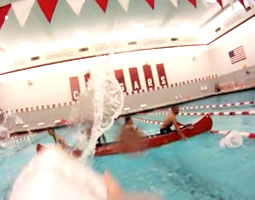“You sunk my battleship!”
A familiar cry from the popular board game, but why is it ringing across Gibb Pool at Washington State University?
Because it is one of the latest offerings in WSU’s long-established and popular intramural sports program, joining perennial favorites flag football, basketball, soccer, and softball.
Battleship—the Gibb Pool version—has teams of four in canoes with buckets and shields. Their goal is simple: To fill their opponents’ canoes with water until they sink, while blocking water from filling their own canoe.
Matt Shaw ’06 MEd, assistant director of competitive programs and youth sports at University Recreation, says the battleship game started last fall and has been popular, but “traditionally flag football has been our biggest sport. In the mid-2000s we were getting nearly 300 teams,” he says.
The intramurals at WSU have long offered students and other members of the University community a chance to be active, meet people, and compete. Students who played basketball, soccer, or other athletics in high school can continue those activities. Others can sample new sports and games, thanks to a variety of leagues at different levels of ability.
“We usually have about 50,000 participations a year in intramurals. About 6,500 different people play every year, and 3,500–4,000 people play each semester,” says University Recreation Programming Director Joanne Greene ’02 MBA.
The sports program started with the Athletic Association of Washington Agricultural College in 1894, when faculty and students at WSU’s earliest incarnation each paid 50 cents a year to participate. While the games have changed, the spirit of friendly competition across the campus remains the same.
In 1897, the college held an “Open Field Day,” when students and faculty competed in such events as the one-mile bicycle race, pole vault, and hurdles. A faculty vs. seniors baseball game in 1898 got its own write-up in the first Chinook. The faculty won 46–14, due in part to the skillful play of chemistry professor Elton Fulmer and botany professor Charles Piper.
As the institution grew, so did the intramurals. The program became more formalized as part of the Department of Physical Education. Competitions among fraternities, sororities, other living groups, and classes became a staple of campus life. In the 1930s, Washington State College basketball coach Jack Friel oversaw the expanding program of sports such as touch football, golf, and boxing.
“I spent more time on intramurals than I did on basketball,” said Friel in a 1982 interview. “I’d have to be up there nights, schedule facilities so it wouldn’t interfere with varsity. We had a lot of people participating. We had three courts for basketball at a time and about six games a night on each court.”
Like battleship and dodgeball now, that era also had its own smaller sports. Horseshoes, archery, and “playground ball” (a past name for softball) filled out the roster.
After a hiatus during World War II, the program continued to grow through the 1950s and 1960s, and included a competition among living groups for overall points across the sports. In 1957–58, more than 3,500 participants from 38 organizations played 20 sports.
That tradition of participation has increased WSU’s reputation for intramural sports, and WSU has consistently won awards for marketing from the collegiate recreation association NIRSA. “We’ve always ranked pretty highly for the size of the school and the percentage of people who play,” says Shaw. “For the most part, students love it.”
But they don’t always love the officiating, says Shaw, something the program continues to improve on with better training for officials. “They might complain about that one night, that one call, and then come back and play all of our sports again,” he says.
The staff encourages those more vocal students to become officials themselves. “We have some people come out and ref and then say, ‘I didn’t realize how hard this was,’” adds Greene.
The intramural program employs 200–300 officials and supervisors each year, many of them officiating several sports and some gaining practicum credit for sports management or other degrees.
Greene and Shaw say they would like to see the program continue to innovate, offering popular sports along with golf tournaments at Palouse Ridge, sand volleyball, table tennis, badminton, and a variety of others. They are sure to draw participants.
“We’re really lucky that we’re in Pullman because we tend to be one of the main attractions. We’re not competing with a lot of other things,” says Greene. “At the same time, that gives us the responsibility to make sure we have things for students to do.”
On the web
UREC executive director begins presidency of national group (WSU News, Mar. 4, 2013)


